Multi-site photoplethysmography technology for blood pressure assessment: challenges and recommendations
Author(s)
Chan, Gabriel; Cooper, Rachel; Hosanee, Manish; Welykholowa, Kaylie; Kyriacou, Panayiotis A.; Zheng, Dingchang; Allen, John; Abbott, Derek; Lovell, Nigel H.; Fletcher, Richard R; Elgendi, Mohamed; ... Show more Show less
Downloadjcm-08-01827-v2.pdf (1.996Mb)
Publisher with Creative Commons License
Publisher with Creative Commons License
Creative Commons Attribution
Terms of use
Metadata
Show full item recordAbstract
Hypertension is one of the most prevalent diseases and is often called the “silent killer” because there are usually no early symptoms. Hypertension is also associated with multiple morbidities, including chronic kidney disease and cardiovascular disease. Early detection and intervention are therefore important. The current routine method for diagnosing hypertension is done using a sphygmomanometer, which can only provide intermittent blood pressure readings and can be confounded by various factors, such as white coat hypertension, time of day, exercise, or stress. Consequently, there is an increasing need for a non-invasive, cuff-less, and continuous blood pressure monitoring device. Multi-site photoplethysmography (PPG) is a promising new technology that can measure a range of features of the pulse, including the pulse transit time of the arterial pulse wave, which can be used to continuously estimate arterial blood pressure. This is achieved by detecting the pulse wave at one body site location and measuring the time it takes for it to reach a second, distal location. The purpose of this review is to analyze the current research in multi-site PPG for blood pressure assessment and provide recommendations to guide future research. In a systematic search of the literature from January 2010 to January 2019, we found 13 papers that proposed novel methods using various two-channel PPG systems and signal processing techniques to acquire blood pressure using multi-site PPG that offered promising results. However, we also found a general lack of validation in terms of sample size and diversity of populations. Keywords: photoplethysmography; digital health; global health; intensive care unit; anesthesia; wearable devices; pulse arrival time; pulse transit time; pulse wave; pulse oximeter; hypertension assessment
Date issued
2019-11-01Department
Massachusetts Institute of Technology. Device Research LaboratoryJournal
Journal of Clinical Medicine
Publisher
Multidisciplinary Digital Publishing Institute
Citation
Chan, Gabriel, et al., "Multi-site photoplethysmography technology for blood pressure assessment: challenges and recommendations." Journal of Clinical Medicine 8, 11 (Nov. 2019): no. 1827 doi 10.3390/jcm8111827 ©2019 Author(s)
Version: Final published version
ISSN
2077-0383